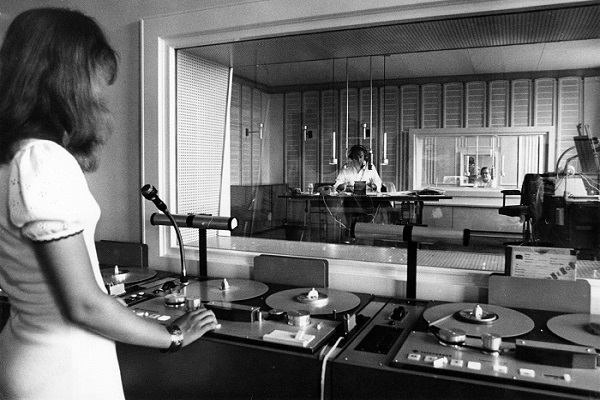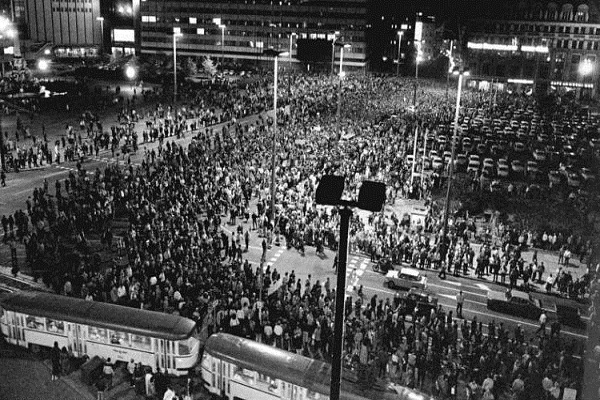 A behind the scenes photo of West Germany’s cross-country radio program RIAS, which was the most popular among East German citizens during the country’s separation in the Cold War. Image: RIAS |
The role of media such as television and
radio is known as a crucial element in German unification. Since East Germany
first permitted East-West TV broadcasts in 1970, Eastern citizens were able to
easily access unbiased information through West German programming. However,
even before that, East Germans were able to gain exposure to West German media
immediately following their separation using illegal means. West Germany sent
information to East Germans about the free world through shortwave radio,
loudspeakers, and leaflets, despite the fact that East Germany tried to block
these efforts using measures like radio signal jamming.
After the country’s division, East Germany
was ruled by an autocratic leadership and was cut off from the outside world.
Despite the East German government’s tactics of punishing listeners and signal
jamming, East German citizens braved the consequences because of their longing
for freedom and information. In this regard, they are similar to pirate radio
listeners in North Korea. Regional experts generally agree that media played a
significant role in changing the perspective of East Germans, inspiring them to
demand freedom of travel to the West, and setting up the foundations for their
protests and planning for unification.
The West German government’s publicly
produced radio played a big role in enlightening the East German people. Just
like today’s situation with North Korea, it was not possible to send a TV
signal to East Germany in the early days. In the 1950s and 1960s, radio
broadcasts were beamed across the border to inform the East German citizens of
the outside world. The Soviet Union was the first to launch a propaganda
broadcast station in the East European bloc. The American led allies
established the Rundfunk im amerikanischen Sektor (RIAS, or Broadcasting Service in the American Sector) radio station on the Western side. After the official
partition of Germany in the Cold War, other allied stations also sprang up,
such as Deutschlandfunk and Deutschewelle.
At the same time in East Germany, all
information being reported came out of the Socialist Unification Party. As part
of an effort to gain an advantage and block foreign influence, they retained a
monopoly on media dissemination. This ensured that no information from the
outside world contradicted the official state positions. On the other
hand, West Germans were privy to reports that updated them about the situation
in East Germany. They were also given access to satire and dramas that depicted
the lives of East Germans. For these reasons, the East Germans had more faith
in the West German media than in their native media outlets.
RIAS editor-in-chief and Deutschewelle
reporter Hans Jürgen Pickert said, “RIAS and the other broadcasters were
originally set up for a West German audience. But the production crew was dead
set on making the signal reach into the East. The East German citizens were
doubly enticed because they know that the same programs they were listening to
were trusted and enjoyed by the West Germans.
An anonymous representative from the Bundespresseamt (Federal Press Office) said, “The West German radio
stations were not devised to change East German thinking or destroy the
Socialist government. They merely focused on conveying information about the
West German people’s daily life. Unexpectedly, this sort of natural style of
broadcasting ended up enlightening a large amount of Eastern listeners and even
helped in eliciting political changes.”
From the 1960s West Germany transmitted
Public Television Station One (Das Erste) and Two (ZDF) into East Germany.
These channels includes news, entertainment, and cultural programming. In the
1970s, the broadcasting of West German stations into the East became even more
widespread. East German native and head of Stasi Records Agency (BStU) Roland Jahn said, “Up until the 1960s, watching TV
from the West was a punishable offense, but it couldn’t hold people back. We
lived in East Germany during the day but in West Germany at night. In the
1970s, there was almost a tacit tolerance for the viewing and listening of
outside media. The Eastern government simply couldn’t hold back the barrage of
interest in Western media.”
The Social Democratic Party’s Willy Brandt
launched the “Look East Policy.” It started to gain momentum at the start of
1973. Up until that point, cross-country communication was limited to
disseminating leaflets across the border and using loudspeakers at key
locations like the Berlin Wall. In the case of the leaflet dissemination, many
departments were involved and it was a thoroughly prepared strategy.
Robert Lebegern is director of the
Deutsch-Deutschen Museum Mödlareuth (Mödlareuth Border Museum). He said, “Western Europe used everything from
rockets, balloons and wind to spread the leaflets. They would release
approximately 500-1000 A4 sized papers at once into East German regions. On the
Eastern side, teachers ordered students to collect the leaflets and then the
Stasi would do an investigation.”
Director Lebegern also said, “For the most part, the loudspeaker broadcasts
went from East Germany to West Germany, but there were also instances of young
people from the West engaging in regular, organized broadcasts using
loudspeakers near the Berlin Wall. These youngsters built a temporary
studio and relayed the news through megaphones.”
“Without the cross-border broadcasts, there
would not have been any peace protests.” According to experts from East
Germany, the West German broadcasts provided “a window to the world,” “a means
to find the strength to go on living,” and “a door to a new consciousness.” But
these broadcasts did not simply convey information, they also provided an
indirect framework for the East Germans to understanding what it meant to live
in a free country. It also stimulated anti-government sentiment and laid the
foundation for unification.
East Berlin native Anna Kaminsky served as
executive director of the Bundesstiftung zur Aufarbeitung der
SED-Diktatur (Federal Foundation for the Reappraisal of
the SED Dictatorship). She said,
“the East Germans who longed for legitimate news and information for so long
did not keep these sources to themselves when they found out how to access West
German radio and TV. They went around discussing the content with their
friends. After interacting with and sharing this content, East Germans began
reflecting upon their own lives. This led them to the difficult task of
recalibrating their mentalities. This type of consciousness grew into the
democratic protests and the border reforms.”
Director Kaminsky continued, “It
is certainly true that the oppressed Germans of the Soviet Bloc were in need of
unbiased information, but I think they needed something more than that. They
needed to hear that they were not being left behind by the free world. They
needed some sense of connection with the Western part of the country.
Cross-border broadcasts thus served both purposes: provided information and
assurance.”
Herbert Wagner was an enthusiastic listener
of Dresden’s Deutschlandfunk and Deutschewelle broadcasts and now serves as the director of Gedenkstätte Bautzner Straße Dresden (Former interrogation prison for District
Dresden of the Ministry of State Security of the GDR) He said, “Western broadcasts gave us
the energy and courage to carry on under difficult conditions and oppression.
If there were never any broadcasts, I likely would have thought that the West
had forgotten about us, and was content to enjoy their freedoms without trying
to assist us. I think the broadcasts became a sort of door for me to use
to escape my immediate surrounding and understand the world at large.”
Jürgen Reiche, Secretary General of Zeitgeschichtliches Forum Leipzig (Leipzig’s Forum for Contemporary
History), remarked that, “even though the
revolutionaries in East Europe did not know one another in the beginning, the
radio broadcasts brought them the information they needed to understand the
true situation. This helped set off a powder keg of anti-government sentiment.
Just as 100,000 people gathered together to start a revolution for peace after
hearing the West German broadcasts in East Germany, South Korean radio
broadcasts into North Korea will have a large impact in terms of influencing
the mindset of North Koreans,” he concluded.
*This article has been brought to you thanks to support from the Korea Press
Foundation.



















